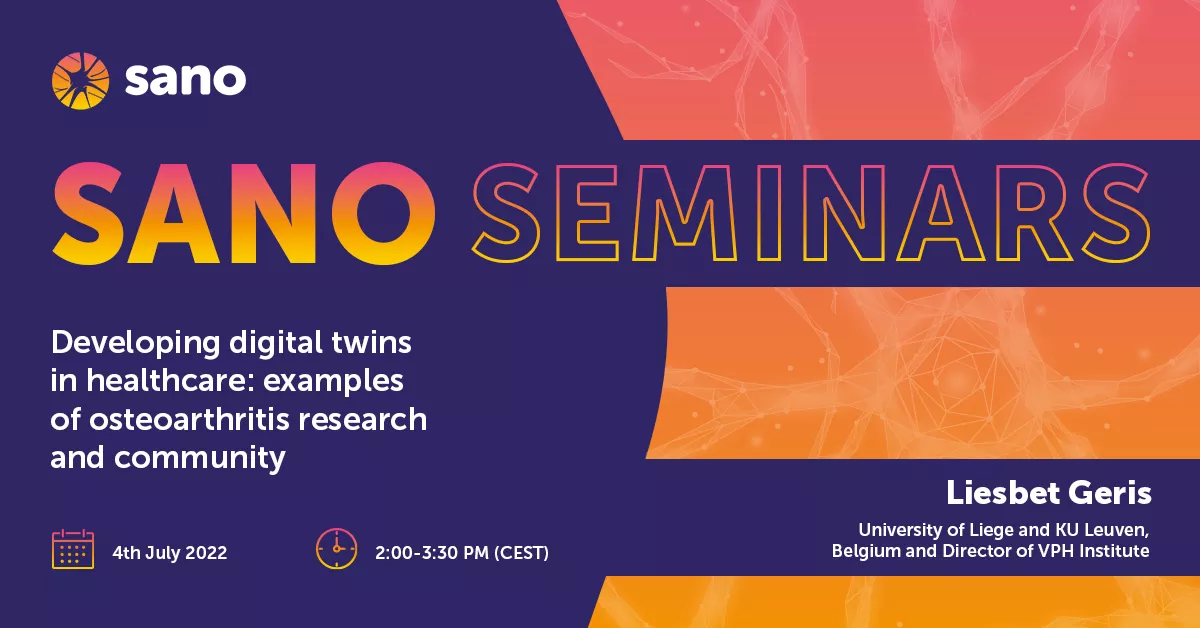
69. Developing digital twins in healthcare: examples of osteoarthritis research and community
Liesbet Geris – University of Liege and KU Leuven, Belgium and Director of VPH Institute
Abstract
The use of computer modeling and simulation in medicine, also called in silico medicine, is taking big strides towards fulfilling its promise: contributing to a faster, safer and more personalised healthare. In silico technologies are increasingly adopted in all aspects of healthcare, from prevention over diagnostics to treatment prediction and clinical follow-up. This progress is owed to a collaborative effort of a wide variety of stakeholders, from researchers to clinicians, from industry to regulators, and from policy makers to funders. In this talk I will start with some tangible examples of in silico medicine in osteoarthritis research, developed in our own research group. Subsequently I will present a number of activities that are ongoing within the wider in silico medicine community.
Long-term changes in mechanical loading In the knee can lead to destabilization of articular homeostasis and a switch of phenotype, as e.g. observed in osteoarthritis (OA). In this context, multiscale models can be used to capture the translation of mechanical signals from the joint level down to the cellular level, and subsequently into intracellular biochemical processes. In our research group, a coupled multiscale model of the human knee joint is being developed to estimate the changes in cell phenotype and activity of the relevant cell secreted factors as a result of (patho)physiological loading at the joint level. The multiscale model incorporates in-silico models at three different length scales: 1) Finite Element (FE) model of the knee joint, 2) FE model of the chondrocyte, and 3) intracellular gene/protein regulatory network for mechanotransduction. Using this multiscale model, the effect of meniscectomy (removal of the meniscus) on the progression of OA was studied. The increased mechanical loading led to a buildup of inflammatory cytokines over time, inducing to a phenotypic switch the chondrocytes. Using the intracellular model, we executed an in-silico screening, complemented by dedicated in-vitro experiments, to identify suitable therapeutic agents to arrest this phenotypic switch in OA.
In order to firmly establish the path from the screen to the patient, several challenges still need to be overcome. In recent years, FDA and ASME published guidelines and standards on reporting, verification and validation of computer models used in the context of medical devices. In Europe, regulators are working together with academia and industry to establish guidelines for the evaluation of in silico technologies (beyond the classical well-regulated pharmacometrics) in drug design and development. Organizations such as the Virtual Physiological Human institute (VPHi, the international scientific society for in silico medicine) and the Avicenna Alliance (the alliance of VPHi and industry) are driving initiatives that will further accelerate the adoption of in silico medicine. One such initiative is the work on ‘Good Simulation Practice’ which will be a quality standard defining how to assess and approve in silico tools before they can be used to produce regulatory evidence on the safety/efficacy of a new medical product. Another initiative is the Community Challenge for the adoption of consensus protocols for the characterization of biological tissue properties (C4bio), which will lead to a ‘certificates of birth’ for the generated data meeting regulatory requirements. Key to all these initiatives is the involvement of multiple stakeholders, which ensures a wide basis for acceptance and uptake of the developed standards and guidelines and which is the only way to remove the remaining barriers for the full adoption of in silico medicine.
About the author
Liesbet Geris is Research Professor in Biomechanics and Computational Tissue Engineering at the university of Liège and KU Leuven in Belgium. Her research focusses on the multi-scale and multi-physics modeling of biological processes. Together with her team and their clinical and industrial collaborators, she uses these models to investigate the etiology of non-healing fractures, to design in silico potential cell-based treatment strategies and to optimize manufacturing processes of these tissue engineering constructs. Liesbet is scientific coordinator of the Prometheus platform for Skeletal Tissue Engineering (50+ researchers). She has edited several books on computational modeling and tissue engineering. She has received 2 prestigious ERC grants (starting in 2011 and consolidator in 2017) to finance her research and has received a number of young investigator and research awards. She is a former member and chair of the Young Academy of Belgium (Flanders) and member of the strategic alliance committee of the Tissue Engineering and Regenerative Medicine Society. She is the current executive director of the Virtual Physiological Human Institute and in that capacity she advocates the use of in silico modeling in healthcare through liaising with the clinical community, the European Commission and Parliament, regulatory agencies (EMA, FDA) and various other stakeholders. Besides her research work, she is often invited to give public lectures on the challenges of interdisciplinary in research, women in academia and digital healthcare.
